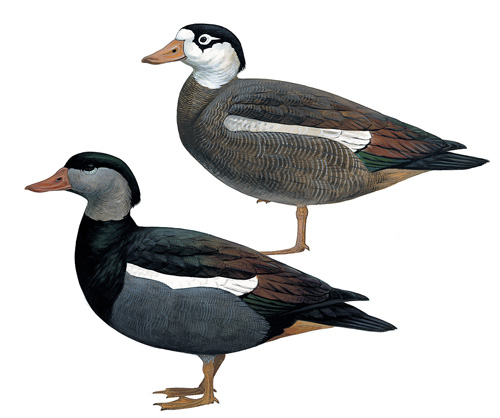Crested Shelduck

Scientific Name
Tadorna cristata
Alternative Names
Korean Crested Shelduck, Korean Sheldrake, Korean Mandarin
Measurements
| Feature | Male | Female |
|---|---|---|
| Length | 63–71 cm (25–28 in) | 63–71 cm (25–28 in) |
| Weight | Not well recorded, likely similar to other shelducks around 1.5–2 kg | Slightly lighter than male |
| Wingspan | Not precisely known, estimated similar to other Tadorna species around 110–130 cm | Same estimate |
Status
Critically Endangered and possibly extinct. There have been no confirmed sightings since 1964, though a few unconfirmed reports continue to surface. Because of this, it remains listed as Critically Endangered rather than declared extinct.
Identification
A medium to large duck with a long body and slender neck. Males have a greenish-black head, breast, wings, and tail, with a brownish-black face and throat. Their belly and flanks are dark grey with black streaks, and the upper wings show white with a green iridescent patch. Females have a white face, throat, and neck, a black crest, and a dark brown body with white streaks. Both sexes have a small green crest or tuft of feathers on the head. The bill and legs are pinkish, with males slightly brighter.
Voice
Its calls are not well documented. It is believed to be mostly quiet like other shelducks, possibly making soft whistles or low calls.
Diet
Feeds on aquatic plants, algae, seeds, invertebrates, small mollusks, crustaceans, and sometimes crops or carrion. May forage during the night.
Distribution
Historically recorded in Korea, eastern Russia near Vladivostok, and possibly northeast China. It may have been more widespread in the past.
Habitat
Uses coastal wetlands, river mouths, lakes, and marshes. Some reports suggest it may also use inland lakes or mountainous wetlands.
Breeding
It is believed to breed from May to July. Like other shelducks, it may nest in burrows, ground cavities, or tree holes. The female likely lays fewer than ten eggs and incubates alone.
Wintering
Thought to migrate from breeding areas in Russia or northern Korea to southern Korea, Japan, and coastal eastern China. Exact wintering grounds remain unconfirmed.
Conservation
Fewer than 50 birds are believed to survive, if any. Threats include hunting, habitat loss, and lack of awareness. Large awareness campaigns once distributed thousands of leaflets in Asia to stop hunters from shooting the species, but no confirmed birds were found. Habitat development projects also threaten possible remaining sites.
